Magnus Karlsson
Department of Science and Technology, Linköping University, Campus Norrköping, Norrköping, Sweden
On the Capacity of Correlated MIMO Phase-Noise Channels: An Electro-Optic Frequency Comb Example
May 09, 2024Abstract:The capacity of a discrete-time multiple-input-multiple-output channel with correlated phase noises is investigated. In particular, the electro-optic frequency comb system is considered, where the phase noise of each channel is a combination of two independent Wiener phase-noise sources. Capacity upper and lower bounds are derived for this channel and are compared with lower bounds obtained by numerically evaluating the achievable information rates using quadrature amplitude modulation constellations. Capacity upper and lower bounds are provided for the high signal-to-noise ratio (SNR) regime. The multiplexing gain (pre-log) is shown to be $M-1$, where $M$ represents the number of channels. A constant gap between the asymptotic upper and lower bounds is observed, which depends on the number of channels $M$. For the specific case of $M=2$, capacity is characterized up to a term that vanishes as the SNR grows large.
Edge-based Parametric Digital Twins for Intelligent Building Indoor Climate Modeling
Mar 07, 2024Abstract:Digital transformation in the built environment generates vast data for developing data-driven models to optimize building operations. This study presents an integrated solution utilizing edge computing, digital twins, and deep learning to enhance the understanding of climate in buildings. Parametric digital twins, created using an ontology, ensure consistent data representation across diverse service systems equipped by different buildings. Based on created digital twins and collected data, deep learning methods are employed to develop predictive models for identifying patterns in indoor climate and providing insights. Both the parametric digital twin and deep learning models are deployed on edge for low latency and privacy compliance. As a demonstration, a case study was conducted in a historic building in \"Osterg\"otland, Sweden, to compare the performance of five deep learning architectures. The results indicate that the time-series dense encoder model exhibited strong competitiveness in performing multi-horizon forecasts of indoor temperature and relative humidity with low computational costs.
Pilot Distributions for Phase Noise Estimation in Electro-Optic Frequency Comb Systems
Jan 25, 2024Abstract:We explore the optimal pilot positioning for phase tracking in electro-optic frequency comb setups. We show that, in contrast to previous results for regular multichannel systems, allocating the first and the last channels for pilots is optimal given a fixed pilot overhead
Learning to Extract Distributed Polarization Sensing Data from Noisy Jones Matrices
Jan 18, 2024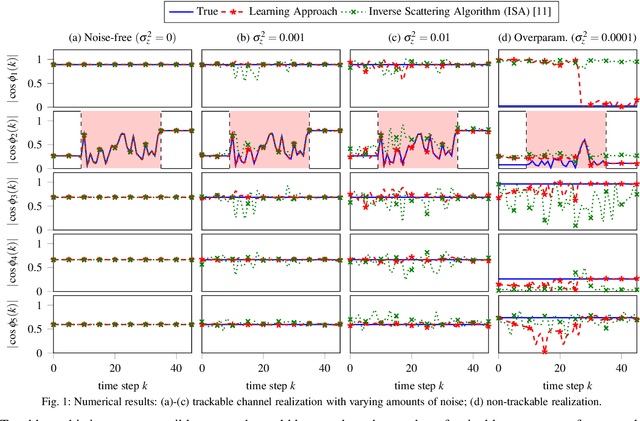
Abstract:We consider the problem of recovering spatially resolved polarization information from receiver Jones matrices. We introduce a physics-based learning approach, improving noise resilience compared to previous inverse scattering methods, while highlighting challenges related to model overparameterization.
Real-Time Monitoring of Cable Break in a Live Fiber Network using a Coherent Transceiver Prototype
Jul 03, 2023

Abstract:We monitor a 524km live network link using an FPGA-based sensing-capable coherent transceiver prototype during a human-caused cable break. Post-analysis of polarization data reveals minute-level potential warning precursors and baseline-exceeding changes directly preceding the break.
Leveraging Deep Learning and Digital Twins to Improve Energy Performance of Buildings
May 16, 2023Abstract:Digital transformation in buildings accumulates massive operational data, which calls for smart solutions to utilize these data to improve energy performance. This study has proposed a solution, namely Deep Energy Twin, for integrating deep learning and digital twins to better understand building energy use and identify the potential for improving energy efficiency. Ontology was adopted to create parametric digital twins to provide consistency of data format across different systems in a building. Based on created digital twins and collected data, deep learning methods were used for performing data analytics to identify patterns and provide insights for energy optimization. As a demonstration, a case study was conducted in a public historic building in Norrk\"oping, Sweden, to compare the performance of state-of-the-art deep learning architectures in building energy forecasting.
Polarization Tracking in the Presence of PDL and Fast Temporal Drift
May 13, 2022

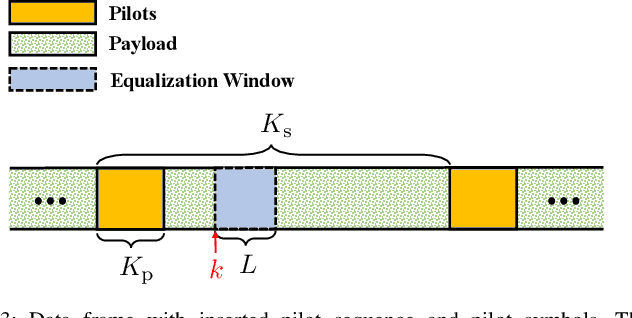

Abstract:In this paper, we analyze the effectiveness of polarization tracking algorithms in optical transmission systems suffering from fast state of polarization (SOP) rotations and polarization-dependent loss (PDL). While most of the gradient descent (GD)-based algorithms in the literature may require step size adjustment when the channel condition changes, we propose tracking algorithms that can perform similarly or better without parameter tuning. Numerical simulation results show higher robustness of the proposed algorithms to SOP and PDL drift compared to GD-based algorithms, making them promising candidates to be used in aerial fiber links where the SOP can potentially drift rapidly, and therefore becomes challenging to track.
Capacity Bounds under Imperfect Polarization Tracking
Dec 23, 2021

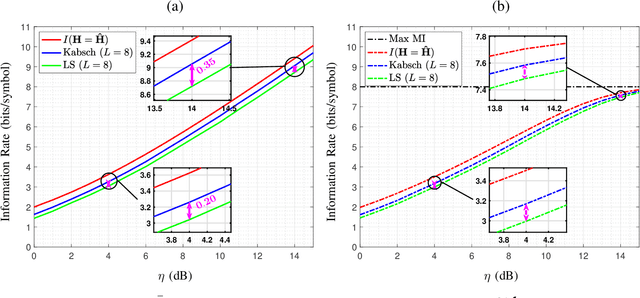
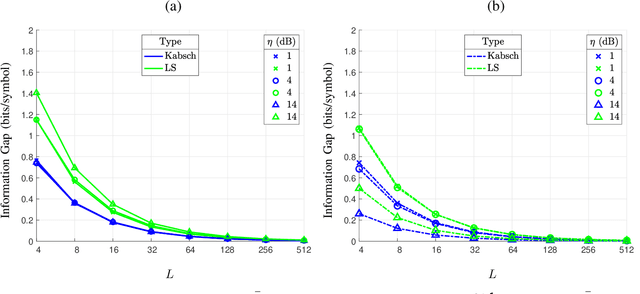
Abstract:In optical fiber communication, due to the random variation of the environment, the state of polarization (SOP) fluctuates randomly with time leading to distortion and performance degradation. The memory-less SOP fluctuations can be regarded as a two-by-two random unitary matrix. In this paper, for what we believe to be the first time, the capacity of the polarization drift channel under an average power constraint with imperfect channel knowledge is characterized. An achievable information rate (AIR) is derived when imperfect channel knowledge is available and is shown to be highly dependent on the channel estimation technique. It is also shown that a tighter lower bound can be achieved when a unitary estimation of the channel is available. However, the conventional estimation algorithms do not guarantee a unitary channel estimation. Therefore, by considering the unitary constraint of the channel, a data-aided channel estimator based on the Kabsch algorithm is proposed, and its performance is numerically evaluated in terms of AIR. Monte Carlo simulations show that Kabsch outperforms the least-square error algorithm. In particular, with complex, Gaussian inputs and eight pilot symbols per block, Kabsch improves the AIR by 0:2 to 0:35 bits/symbol throughout the range of studied signal-to-noise ratios.
Over-the-fiber Digital Predistortion Using Reinforcement Learning
Jun 09, 2021

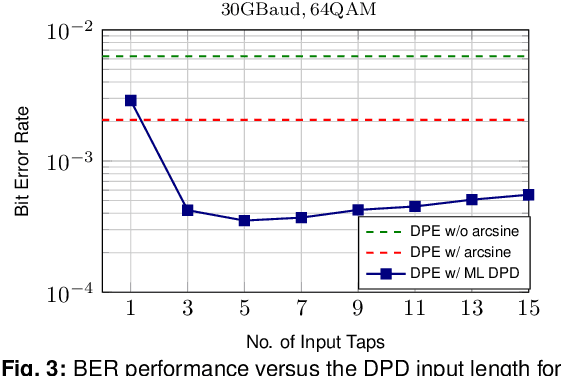
Abstract:We demonstrate, for the first time, experimental over-the-fiber training of transmitter neural networks (NNs) using reinforcement learning. Optical back-to-back training of a novel NN-based digital predistorter outperforms arcsine-based predistortion with up to 60\% bit-error-rate reduction.
Compressed Shaping: Concept and FPGA Demonstration
Feb 08, 2021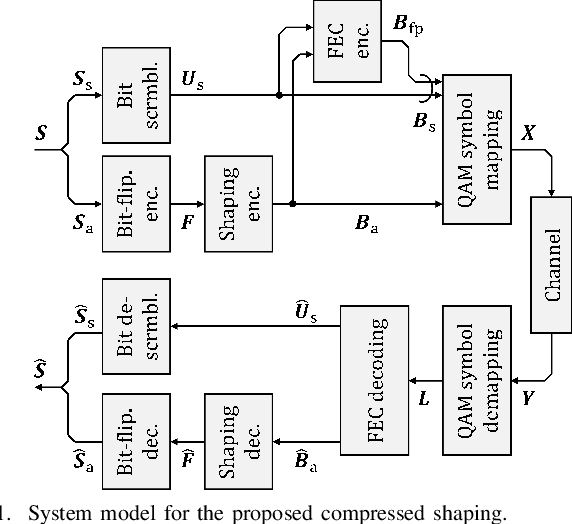
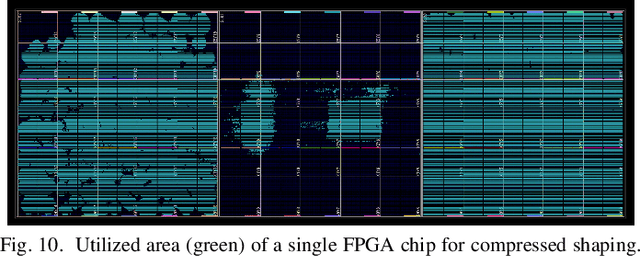
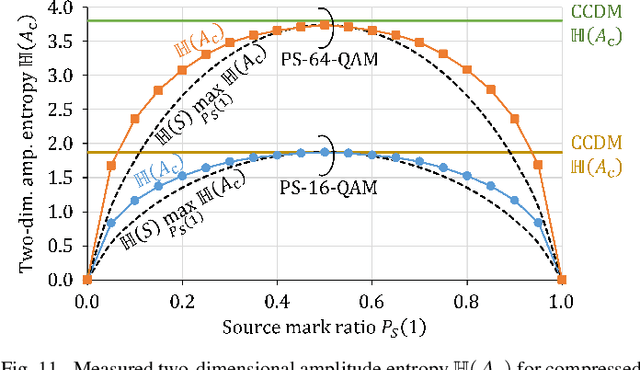
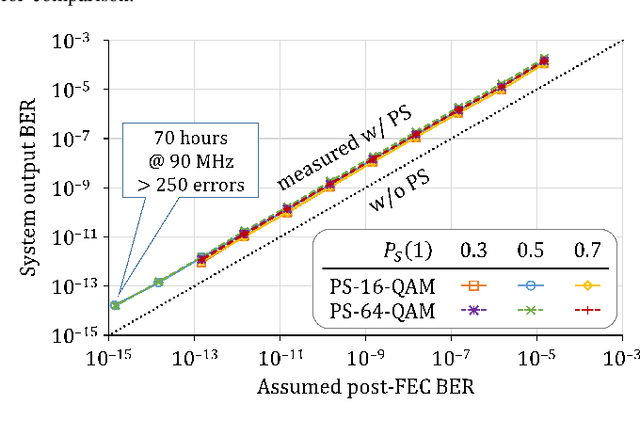
Abstract:Probabilistic shaping (PS) has been widely studied and applied to optical fiber communications. The encoder of PS expends the number of bit slots and controls the probability distribution of channel input symbols. Not only studies focused on PS but also most works on optical fiber communications have assumed source uniformity (i.e. equal probability of marks and spaces) so far. On the other hand, the source information is in general nonuniform, unless bit-scrambling or other source coding techniques to balance the bit probability is performed. Interestingly,one can exploit the source nonuniformity to reduce the entropy of the channel input symbols with the PS encoder, which leads to smaller required signal-to-noise ratio at a given input logic rate. This benefit is equivalent to a combination of data compression and PS, and thus we call this technique compressed shaping. In this work, we explain its theoretical background in detail, and verify the concept by both numerical simulation and a field programmable gate array (FPGA) implementation of such a system. In particular, we find that compressed shaping can reduce power consumption in forward error correction decoding by up to 90% in nonuniform source cases. The additional hardware resources required for compressed shaping are not significant compared with forward error correction coding, and a real-time back-to-back test is successfully demonstrated.
 Add to Chrome
Add to Chrome Add to Firefox
Add to Firefox Add to Edge
Add to Edge